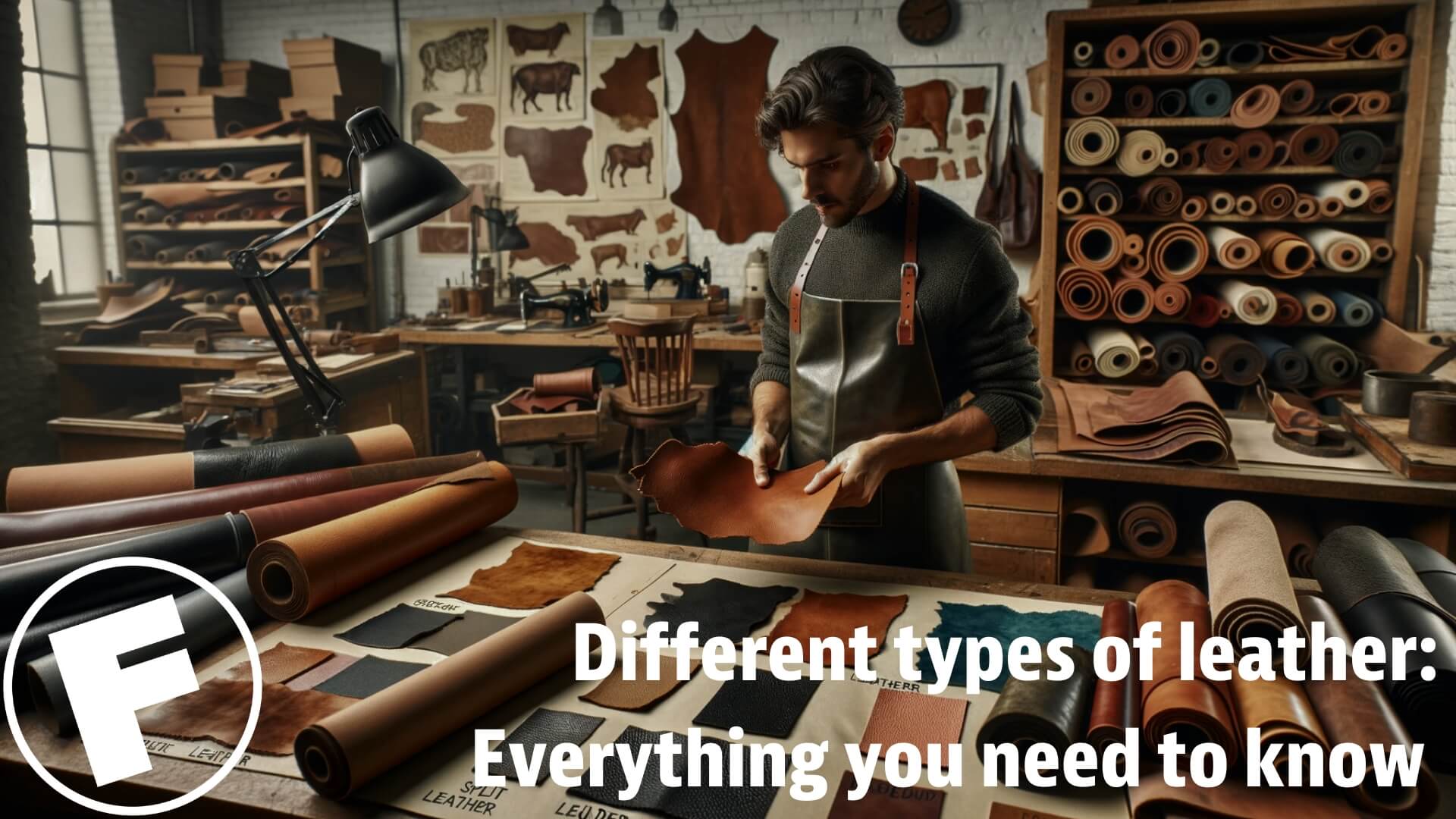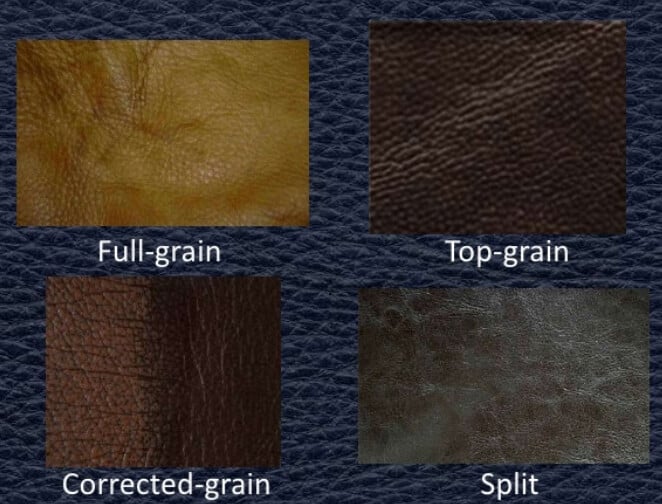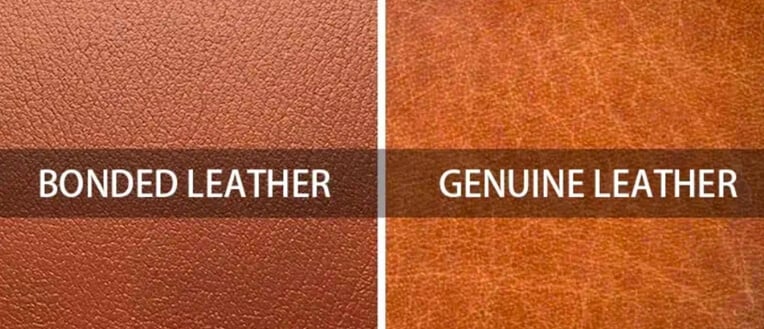Types of Leather: Must-Know Info for Buying Leather
All the different types of leather can make your head spin. Either because you aren’t sure what you should look for when it comes time to buy new furniture, or because they have a problem (like a scratch or stain) that needs to be fixed.
This quick guide should help you understand the big picture. Read on!

The six main types of leather
Leather is typically separated into six main types. The final one isn’t actually leather per see, but it’s worth mentioning in any conversation regarding leather products.
Full grain leather
Fully finished leather is a type of leather that has undergone a comprehensive and meticulous treatment process to achieve a uniform and flawless appearance. During production, the leather is carefully sanded, buffed, and corrected to remove any natural imperfections, such as scars, blemishes, or grain irregularities.
This meticulous process ensures that the leather surface is smooth and consistent, devoid of any natural marks or variations. Additionally, fully finished leather is often dyed using an opaque pigment, which further enhances its uniformity by covering the natural color variations and providing a consistent, vibrant hue. This type of leather is prized for its impeccable and pristine appearance, making it a popular choice for items like high-end furniture, luxury handbags, and automotive upholstery, where a flawless finish is desired.
Fully finished leather not only boasts a consistent look but also tends to be more resistant to wear and stains compared to other types of leather. The application of pigmented coatings provides a protective layer, making it easier to maintain and clean. However, some argue that this process may sacrifice the breathability and natural character of the leather.
Despite this, fully finished leather remains a preferred choice for those seeking a polished and sophisticated aesthetic in their leather products while prioritizing durability and ease of maintenance.
Key attributes:
- Full-grain leather is the highest quality and most durable type of leather.
- It is made from the top layer of the animal hide, which contains the strongest and most tightly packed fibers.
- This leather retains the natural grain, imperfections, and markings, giving it a unique and rugged appearance.
- It develops a beautiful patina over time and is often used for high-end products like saddles, belts, wallets, and premium footwear.
Top grain leather
Top-grain leather is a high-quality type of leather that is derived from the top layer of animal hides, specifically the outermost part just beneath the hair. It is considered one of the finest grades of leather due to its durability and desirable characteristics.
During the tanning process, the top grain is carefully separated from the lower layers, resulting in a material that retains the natural grain pattern and texture while undergoing minimal processing. Top-grain leather is known for its smooth and supple surface, making it a popular choice for a wide range of products, including wallets, belts, upholstery, and fine leather goods like handbags and shoes. Its natural grain and inherent strength make it an excellent compromise between durability and a refined appearance.
One distinguishing feature of top-grain leather is that it can be further enhanced through various finishing techniques. This allows manufacturers to create a variety of finishes, from matte to glossy, depending on the desired aesthetic.
While top-grain leather is less rugged-looking than full-grain leather due to its subtle surface corrections, it still offers exceptional quality and longevity, making it a sought-after option for those who appreciate both style and substance in their leather products. It strikes a balance between the natural beauty of leather and a polished, sophisticated finish, making it a versatile choice for a wide range of applications.
Key attributes:
- Top-grain leather is also made from the top layer of the hide but is sanded and buffed to remove imperfections.
- It has a smoother surface compared to full-grain leather but is still durable and retains some of the natural grain.
- Top-grain leather is commonly used in making high-quality leather furniture, jackets, and handbags.

A comparison between four key types of leather.
Corrected-grain leather aka “Genuine leather“
Corrected leather is a type of leather that has undergone significant treatment and modification to conceal natural imperfections and irregularities in the leather’s surface. During the production process, the hide is carefully sanded, buffed, and corrected to remove blemishes, scars, wrinkles, and other flaws that may be present. In some cases, a pigment or coating is applied to create a uniform and flawless appearance.
This meticulous process results in a leather surface that is smooth and consistent, but it often loses the natural grain and texture found in full-grain or top-grain leather. Corrected leather is a popular choice for items like budget-friendly furniture, automotive upholstery, and certain types of shoes where cost-effectiveness and a more consistent appearance are prioritized over the distinctive character of the leather.
While corrected leather may lack the natural beauty and authenticity of other leather types, it is appreciated for its affordability and resistance to wear and tear. The correction process provides a protective layer that makes the leather less susceptible to stains, scratches, and damage. Additionally, corrected leather requires less maintenance compared to full-grain or top-grain leather.
However, it is essential to note that the loss of natural characteristics and breathability may be seen as a drawback for those who value the unique texture and aging properties of uncorrected leather. Ultimately, the choice between corrected leather and other leather types depends on individual preferences and priorities for the specific application.
Key attributes:
- Corrected-grain leather is made from lower-quality hides or hides with significant imperfections.
- The surface is heavily sanded and treated with dyes and pigments to create a more uniform appearance.
- While it may lack the natural characteristics of full-grain or top-grain leather, it is more affordable and suitable for items like budget furniture and fashion accessories.
Split grain leather
Split-grain leather is a type of leather that is derived from the lower layers of an animal hide, specifically the split or suede side. During the leather production process, the hide is often split into two layers: the top grain, which is used to make full-grain or top-grain leather, and the lower split, which becomes split-grain leather. This type of leather has a distinctive appearance, characterized by a fuzzy or suede-like surface texture, lacking the smoothness and natural grain pattern found in top-grain or full-grain leather.
Split-grain leather is commonly used for applications where a suede-like texture is desired, such as in the making of jackets, gloves, upholstery, and some types of bags and accessories.
One key characteristic of split-grain leather is its softness and flexibility. Due to its location in the hide, it tends to be more pliable and comfortable from the start compared to top-grain or full-grain leather. However, it also tends to be less durable and more susceptible to wear and tear over time.
Split-grain leather may require more maintenance and protection against stains and moisture. While it may not possess the same ruggedness or longevity as other leather types, it is valued for its unique texture and comfort, making it a suitable choice for specific fashion and upholstery applications.
Key attributes:
- Split leather is derived from the lower layers of the hide after the top-grain is separated.
- It is less durable and has a fibrous texture, making it suitable for suede production.
- Suede is created by buffing and sanding the split leather’s inner surface to create a soft, napped finish used in garments, shoes, and accessories.
Bonded leather aka “Reconstituted leather”
Bonded leather, often referred to as “reconstituted leather” or “blended leather,” is a type of leather-like material that is made by combining scraps or fibers of genuine leather with synthetic materials, such as polyurethane (PU) or vinyl.
The process involves shredding or pulverizing leather remnants and then adhering them together with adhesives and synthetic coatings.
While bonded leather contains some genuine leather content, it typically consists of a much higher proportion of synthetic materials, with only a small percentage of actual leather fibers. The result is a material that resembles the look of genuine leather but lacks many of its essential qualities, such as durability and longevity.
Bonded leather is often used to create lower-cost alternatives to genuine leather products. It is commonly found in furniture upholstery, inexpensive wallets, belts, and some lower-end fashion accessories. While it can mimic the appearance of leather to some extent, bonded leather is generally less durable, less breathable, and more susceptible to peeling, cracking, and wear over time compared to full-grain or top-grain leather.
Consumers should be cautious when purchasing products labeled as “bonded leather” to ensure they are aware of the material’s quality and longevity, as it may not offer the same level of performance or longevity as genuine leather.

Comparing bonded vs genuine leather.
Faux “leather”
Faux leather, also known as synthetic leather or vegan leather, is a man-made material designed to imitate the look and feel of genuine leather without using animal-derived materials. It is created using various synthetic substances, with the most common ones being polyurethane (PU) and polyvinyl chloride (PVC).
Faux leather is a popular and ethical alternative to genuine leather, as it does not involve the use of animal hides. It is widely used in the fashion industry to make clothing, footwear, handbags, and accessories, as well as in furniture upholstery and interior design applications.
Faux leather offers several advantages, including affordability, versatility, and the ability to achieve a wide range of colors and textures. It is often easier to clean and maintain than genuine leather, as it is less prone to staining and does not require special conditioning.
While faux leather can resemble real leather to a significant degree, it may lack some of the natural characteristics and breathability of genuine leather. The quality of faux leather products can vary, so it’s essential to choose well-made items for better durability and a more convincing appearance.
Other leather terms and varieties
Fully finished leather
Fully-finished leather, seen frequently in furniture brands like Lazy Boy, Palliser, Natuzzi and Elite as well as in automotive interiors, has a durable surface finish that resists scratches and staining. Fully-finished leathers make up approximately 85% of leather used for furniture and 99% of leather used in the automotive industry today.
If you have kids, pets or messy guests, Fully-finished leather is the way to go. If you have a spill on fully-finished leather, just clean it up quickly with a damp rag and wipe dry with a dry towel – simple as that.
Semi-aniline Leather:
Semi-aniline leather is often made from a hide with fewer blemishes than fully-finished leather. These leathers are transparently dyed and have a thin surface coating that makes them more durable than aniline leather (see information below), but less durable than fully-finished leather.
Semi-aniline leather has a soft surface that feels like it has a film on it – this is the thin surface coating. These leathers can be cleaned, and most stains and scratches are relatively easy to solve professionally.
Aniline Leather:
Aniline leathers have a transparent dye that allows the natural beauty of
the leather to show through, but anilines don’t have a surface coating. The downside to these beautiful aniline leathers is that they stain and scratch very easily and are generally more difficult to repair.
You’ll know you’re looking at aniline leather because is the most natural feeling of all leathers and is soft to the touch.
You’ll hear the words “pure aniline,” “wax and oil pull-ups” and “raw leathers” all referencing leather that has no surface finish. That is what we refer to as aniline. This leather is rare (less than 15 percent of the leather market) and is often expensive.
And some more esoteric types of leather:
- Nubuck Leather:
- Nubuck leather is similar to suede but is made from the top-grain of the hide.
- It is sanded to create a fine, velvety texture and is more durable than traditional suede.
- Nubuck is often used for high-end shoes, belts, and bags.
- Exotic Leather:
- Exotic leather is sourced from animals like alligators, crocodiles, snakes, ostriches, and more.
- Each exotic leather type has unique textures and patterns, making them highly prized for luxury products like handbags, boots, and accessories.
- Vegetable-Tanned Leather:
- Vegetable-tanned leather is processed using tannins from natural plant sources.
- It is known for its stiffness and ability to age beautifully, darkening over time.
- Commonly used in tooling, carving, and crafting of items like belts, wallets, and saddles.
- Chrome-Tanned Leather:
- Chrome-tanned leather is processed using chromium salts.
- It is softer, more flexible, and quicker to produce than vegetable-tanned leather.
- Often used for fashion items like shoes, bags, and upholstery.
Leather is a rich and complex material that goes far beyond the standard 5 types and additional terms. The best type of leather really comes down to the style, look, and standard of quality that best suit your needs specifically!
The thrill of the hunt is made all the more exciting but just how dynamic leather is.
Consult a Fibrenew expert for all your leather questions and needs
We’re always here to give you peace of mind when it comes to all things leather.
Get in touch with your local Fibrenew operator for any questions.
And if you’re passionate about leather, maybe a career in leather repair and restoration is the path for you. Check our free Franchise Information Report for everything you need to know.
Until next time!
Leather types FAQ
What is the best leather? Full-grain leather is generally regarded as the highest quality among all types of leather. How much do different leathers vary in quality? Leather can vary significantly in quality, and the quality of leather is influenced by several factors, including the source of the hide, the tanning process, and the overall treatment it undergoes. Which leather has the longest lifespan?


